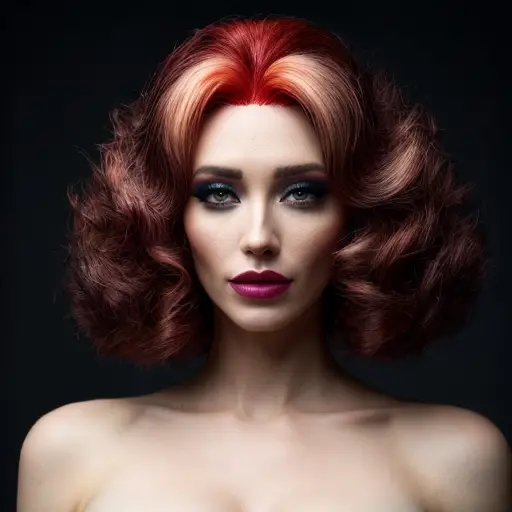The Historical Context: Unveiling the Origins of Wig-Wearing in English Society
In the grand tapestry of English history, there lies a peculiar phenomenon that has both baffled and amused scholars for centuries: the widespread adoption of wigs and makeup by Englishmen. Now, one might wonder, why on earth would these fine gentlemen, known for their stiff upper lips and love for tea, choose to adorn themselves with such flamboyant accessories? Well, dear readers, the answer lies in the intricate web of historical context. You see, back in the 17th and 18th centuries, a series of unfortunate events occurred, including outbreaks of syphilis and rampant hair loss due to questionable hygiene practices. Faced with the prospect of a shiny, bald pate, Englishmen turned to wigs as a fashionable solution, transforming their heads into elaborate works of art. And as for the makeup, well, who wouldn't want to hide the evidence of a late-night rendezvous with a pint or two? So, next time you stumble upon a portrait of a bewigged English gentleman, remember that behind that powdered facade lies a tale of vanity, disease, and a desperate need for a good hair day.
Fashion and Social Status: Exploring the Role of Wigs and Makeup in Englishmen's Attire
One interesting fact about why Englishmen wore wigs and makeup is that it was actually a fashion trend that originated from a rather unexpected source - a widespread outbreak of syphilis in the 16th and 17th centuries. During this time, syphilis was a highly stigmatized and prevalent disease in Europe, including England. Its symptoms often included hair loss, skin lesions, and facial disfigurement. To hide these physical signs, both men and women started wearing wigs and applying heavy makeup. Wigs became particularly popular among Englishmen as they not only covered up the baldness caused by syphilis but also provided an opportunity to showcase their wealth and social status. These wigs were made from a variety of materials, including human, horse, or goat hair, and were often elaborately styled and powdered with scented powders to mask any unpleasant odors. Makeup, on the other hand, was used to conceal the skin lesions and scars caused by syphilis. Men would apply a thick layer of white lead-based foundation, which was believed to give them a more youthful and healthy appearance. They would also use rouge on their cheeks and lips to add color and create a more vibrant complexion. While the initial reason for wearing wigs and makeup was to hide the effects of syphilis, these fashion trends soon became popular among the upper classes in England, even after the disease's prevalence declined. Wigs, in particular, became a symbol of status and fashion, with men of all backgrounds adopting the trend. This cultural phenomenon lasted for several centuries, eventually evolving into a fashion statement rather than a necessity born out of a disease.
In the realm of English society, where appearances held great significance, wigs and makeup became powerful tools for asserting one's social status. Picture this: a grand ballroom filled with elegantly dressed gentlemen, each vying for attention and admiration. In this competitive landscape, wigs became a symbol of wealth and prestige. The more elaborate and towering the wig, the higher one's position in society. It was a way for Englishmen to showcase their affluence and elevate themselves above the common folk. As for makeup, it served a dual purpose. Not only did it enhance one's features and mask imperfections, but it also signaled refinement and sophistication. A perfectly powdered face and delicately rouged cheeks were the hallmarks of a gentleman who had the time and resources to invest in his appearance. So, while wigs and makeup may seem frivolous to us today, they were once essential elements in the intricate dance of social hierarchy in English society.
Cultural Influences: Unraveling the Impact of French and European Trends on English Wig and Makeup Fashion

In the realm of fashion, trends have a way of transcending borders and leaving their mark on different cultures. Such was the case with the adoption of wigs and makeup by Englishmen, which can be traced back to the influence of French and European styles. During the 17th and 18th centuries, France was considered the epitome of fashion and elegance, and English society looked to its continental neighbor for inspiration.
The French court, led by the flamboyant King Louis XIV, set the stage for the wig-wearing craze. As the trend gained momentum across Europe, Englishmen eagerly embraced it as a means of emulating the sophistication and refinement associated with the French aristocracy. Wigs became a status symbol, reflecting not only wealth but also a desire to align oneself with the cultural elite.
But it wasn't just the French who left their mark on English wig and makeup fashion. European influences, particularly from Italy, also played a significant role. Italian opera singers, known for their extravagant costumes and dramatic makeup, captivated English audiences. This theatrical influence seeped into everyday fashion, with Englishmen seeking to emulate the grandeur and allure of the stage.
The adoption of wigs and makeup was not merely a superficial trend; it represented a cultural shift in English society. It signaled a growing fascination with continental Europe and a desire to be seen as cosmopolitan and refined. Englishmen saw wigs and makeup as a way to elevate their social standing and align themselves with the cultural zeitgeist of the time.
So, the next time you come across a portrait of an English gentleman sporting a towering wig and a powdered face, remember that behind that fashionable facade lies a story of cultural influence and a quest for social acceptance in a rapidly changing world.
Symbolism and Self-Expression: Understanding the Psychological Motivations Behind Englishmen's Wig and Makeup Choices
Fun fact: Englishmen in the 17th and 18th centuries wore wigs and makeup not only as a fashion statement but also as a clever way to combat head lice! Due to poor hygiene practices and the prevalence of lice during that time, wigs became a popular solution to hide any infestations. Additionally, the wigs were often powdered with scented substances like lavender or orange blossom, which helped mask any unpleasant odors caused by lack of regular bathing. So, while wigs and makeup were initially worn for fashion, they inadvertently served as a practical solution to a pesky problem!
Beyond the realm of fashion and social status, the adoption of wigs and makeup by Englishmen held deeper psychological motivations. In a society where conformity and rigid social norms prevailed, wigs and makeup became a means of self-expression and individuality. Englishmen used these accessories to project their desired image to the world, to create a persona that went beyond their everyday selves. Wigs, with their extravagant styles and colors, allowed men to transform into characters of their own making, whether it be a distinguished statesman or a dashing libertine. Makeup, on the other hand, provided a canvas for personal creativity, enabling men to experiment with different looks and express their unique sense of style. In a world where conformity reigned supreme, wigs and makeup became powerful tools for Englishmen to assert their individuality and break free from the constraints of societal expectations.

